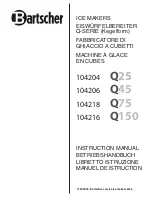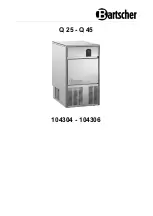
PC-ES1209_IM_new
17.08.20
61
Cleaning
WARNING:
•
Before cleaning, always remove the mains plug and wait until
the appliance has cooled down.
• Do not immerse the appliance in water. Otherwise this might
result in an electric shock or fire.
•
The steam nozzle is hot immediately after use!
CAUTION:
•
Do not use a wire brush or any abrasive items.
•
Do not use any acidic or abrasive detergents.
Clean the casing with a slightly damp cloth without deter-
gents.
Group Head and Rubber Seal
Wipe group head and rubber seal with a damp cloth. Use
a soft nylon brush to remove stubborn residues. Dry with a
soft cloth.
Accessories
You can clean the filter holder, filter inserts, the drip tray
grid, drip tray, the measuring spoon, the water tank, and
the steam nozzle in a warm rinsing bath. Use a soft nylon
brush, if necessary. Rinse with clean water. Dry all parts
with a soft cloth.
CAUTION:
These parts are not dishwasher-safe. Heat and aggres
-
sive detergents can cause distortion and discolouration.
Water Tank
1.
Pull the tank with both hands up and out. Replace the
tank after cleaning and drying.
NOTE:
The water tank has two hooks.
2.
Hook the water tank into the two eyelets of the appliance.
3.
Press the water tank slightly down for the valve to open.
Steam Nozzle
Clean the steam pipe and the attached steam nozzle
immediately after preparing milk foam. Dry milk residue is
difficult to clean.
1.
Pull off the steam nozzle. Leave it for some time in the
warm rinsing bath. In this way milk residue is easily
removed.
2. Wipe the steam nozzle on the appliance with a damp
cloth.
NOTE:
Fill a bowl with hot water to remove dry residue. Set
it so under the steam tube that it is immersed in the
rinsing bath.
3.
After cleaning, slide the steam nozzle back onto the
steam pipe. Place a heat-resistant empty bowl under the
steam nozzle.
Operate the appliance as instructed under “Making Cap-
puccino” points 4 and 5. After cleaning the steam nozzle
is again ready to use.
Decalcification
Scale deposits put the functionality of your appliance at
risk. It is necessary to decalcify the appliance regularly. The
intervals depend on use frequency and water hardness.
Decalcify with a commercial decalcifier for coffee machines.
1. Dose as instructed on the packaging or on the instruction
leaflet.
2. Operate the appliance as instructed for making espresso
until the tank is empty. Let the solution flow through the
group head (without filter holder).
WARNING:
•
Rinse the water tank and let one full tank fresh water
flow through the group head to rinse out the decalcifier
residues.
• Do
not
use this water for consumption.
Storage
• Clean the appliance as described and let it dry com-
pletely.
• We recommend that you store the appliance in its
original packaging when it is not to be used for a longer
period.
•
Always store the appliance at a well ventilated and dry
place outside the reach of children.
Summary of Contents for 4006160012095
Page 86: ...PC ES1209_IM_new 17 08 20 86...
Page 87: ...PC ES1209_IM_new 17 08 20 87 8 8 8...
Page 91: ...PC ES1209_IM_new 17 08 20 91 3 5 1 2 OFF 1 2 3 4 5 6 7 8 MAX OFF 50 OFF 9 10 11 12...
Page 92: ...PC ES1209_IM_new 17 08 20 92 1 2 3 1 2 3 4 5 1 2...
Page 93: ...PC ES1209_IM_new 17 08 20 93 MAX...
Page 94: ...PC ES1209_IM_new 17 08 20 94 4 1 2 1 1 2 1 3 5 2009 125 EC 20...
Page 95: ...PC ES1209_IM_new 17 08 20 95 PC ES 1209 220 240 50 60 850 1 8 20 4 CE...
Page 96: ...PC ES1209_IM_new 17 08 20 96 PC ES 1209 60 50 240 220 850 1 8 I 20 4 CE 3 5 EC 125 2009 20...
Page 97: ...PC ES1209_IM_new 17 08 20 97 MAX 4 2 1 1 2 1 1...
Page 98: ...PC ES1209_IM_new 17 08 20 98 1 2 3 1 2 3 5 4 1 2...
Page 102: ...PC ES1209_IM_new 17 08 20 102 8 8 8...
Page 104: ...PC ES1209_IM_new 17 08 20...
Page 105: ...PC ES1209_IM_new 17 08 20...
















































